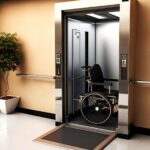NYC’s accessibility compliance for doors is an important consideration when constructing, renovating or replacing commercial building doors.
Ensuring that doorways are compliant with the Americans With Disabilities Act (ADA) requirements promotes a safe and comfortable environment for all types of people.
This guide provides information on meeting NYC’s accessibility compliance regulations for doors as set by the New York City Department of Buildings (DOB).
The DOB has established specific guidelines to ensure buildings have suitable accommodations regarding access points such as entrances, passageways, ramps, lifts, and other related components.
In addition to design specifications, these guidelines also include installation details necessary for successful completion of projects which comply with the ADA standards.
By following this guide it will provide insight into how to meet NYC’s accessibility compliance in regards to doors.
Nyc Accessibility Compliance Code Requirements
The NYC Accessibility Compliance Code requires barrier free design and universal access when constructing or modifying doors. This code is based on the nationally recognized Americans with Disabilities Act (ADA) Standards for Accessible Design, as applicable to New York City buildings. It applies to all public facilities and commercial establishments in the city that are subject to state accessibility requirements.
The compliance code addresses issues such as maneuvering clearances at doors and door hardware operation force requirements, which help ensure equal access for people of all abilities and mobility levels. In addition, provisions also address special needs related to visual impairments, hearing impairments and speech disabilities.
To ensure full compliance with these regulations, it is important to familiarize yourself with the range of design specifications for doors outlined in the NYC Accessibility Compliance Code prior to any construction project.
Design Specifications For Doors
In order to meet the requirements of New York City’s Accessibility Compliance Code, it is important to understand the design specifications for doors. This includes choosing door materials that are durable and can withstand heavy use; ensuring that opening widths are 32 inches minimum and 48 inches maximum; and including a clear floor space in front of the door so wheelchairs have enough room to maneuver.
Additionally, when considering what material to choose for your door, you should also consider its noise reduction qualities and how easy it will be to clean and maintain. After selecting appropriate materials for your door, installers must adhere strictly to all applicable guidelines during installation in order to ensure compliance with NYC regulations.
Installation Guidelines For Doors
Doors must possess a number of features to ensure they meet NYC’s accessibility compliance standards, such as ease-of-use and durability.
These door features include appropriate sizes for both the handle and lever, space between doors that allows wheelchairs to pass through easily, adequate weighting so that manual operation is possible, door security mechanisms to prevent unauthorized access, and more.
An important aspect of meeting these requirements is ensuring proper installation and maintenance of the door components by professional contractors or technicians with expertise in this area.
Adhering to these guidelines helps guarantee the safety and satisfaction of all users who interact with the door.
With sound construction methods and materials used during installation, it creates a strong foundation for successful testing and certification requirements.
Testing And Certification Requirements
Once the installation guidelines for doors have been addressed, it is important to understand and adhere to the testing and certification requirements.
Every door must be tested in accordance with relevant accessibility standards and certified by a qualified individual or team. This process should include comprehensive records of each test conducted as well as any corrective action taken when necessary.
Additionally, personnel involved in this process must demonstrate an understanding of current accessibility compliance regulations through completion of appropriate training sessions. The results of such tests are essential components of demonstrating that all applicable accessibility criteria have been met.
It is only then that a door can be certified compliant with local laws and regulations.
Frequently Asked Questions
Q: What Are The Costs Associated With Accessibility Compliance For Nyc Doors?
Ans: When it comes to meeting NYC’s accessibility compliance requirements for doors, there are associated costs that need to be taken into consideration.
These can include the cost of labor and materials needed to bring a door up to safety standards as required by the Americans with Disabilities Act (ADA).
Additional fees may also be incurred depending on the complexity of the project.
For example, if an existing door needs to be replaced or upgraded in order to meet ADA standards, then additional expenses such as purchasing new parts or hiring professionals may become necessary.
It is important to note that these costs will vary depending on the particular situation and should be thoroughly researched before any decisions are made.
Q: Are There Any Grants Or Incentives Available To Help Offset The Costs Of Compliance?
Ans: Navigating the costs associated with meeting accessibility compliance for New York City’s doors can be a daunting task – one that may seem impossible without some help.
Fortunately, there are several funding sources and incentives available to lighten this burden. These resources include grants, tax credits, and loans designed to assist in offsetting the cost of an accessibility audit or any related compliance work needed to make doors accessible.
Furthermore, it is important to consult local experts when considering these options as they will have specific knowledge on how best to take advantage of such programs.
Q: How Long Does It Typically Take To Install Compliant Doors?
Ans: The installation process for compliant doors typically varies depending on the size and complexity of the door. Generally, a single entry door with standard widths can be installed within one day.
However, if wider than average door widths are required due to accessibility compliance regulations, extra time may be needed in order to install additional components such as hinges and hardware that can support the increased weight of the larger door.
Additionally, labor costs for installation should also be taken into consideration when determining how long it will take to complete the task.
Q: Are There Any Special Considerations For Older Buildings?
Ans: Considering the current H2 of ‘Are there any special considerations for older buildings?’, it is important to take into account building codes, safety standards, and accessibility compliance requirements when making modifications.
In particular, if a building has been in use for an extended period of time, or was constructed before certain regulations were put in place, extra care must be taken to ensure all doorways meet modern accessibility specifications.
This can include taking measurements from multiple angles as well as consulting with experts regarding best practices for bringing these structures up-to-date without compromising their original integrity.
Q: Does The Nyc Accessibility Compliance Code Apply To Interior Or Exterior Doors?
Ans: The NYC Accessibility Compliance code applies to both interior and exterior doors, with requirements for door sizes and opening types.
Generally, the minimum clear width of an accessible doorway is 32 inches when not in use and 36 inches when in use. If a swinging or sliding door is used, it must have at least a 48 inch wide clearance.
Other considerations include providing openings that are easy to open with no more than 5 lbs of force, using low-pile carpeting on either side of the door threshold and ensuring maneuvering space can be provided around any obstruction near the door.
Conclusion
Compliance with accessibility laws for doors in NYC is essential for businesses and organizations. The cost can be substantial, but there are grants and incentives available to offset the upfront costs.
It typically takes several weeks or more depending on the installation of compliant doors, as well as any special considerations needed for older buildings. Additionally, it’s important to note that both interior and exterior doors must adhere to NYC Accessibility Compliance Code requirements.
Overall, compliance with these regulations requires thoughtful planning, skillful implementation and financial resources. However, the benefits far outweigh the costs because they ensure an inclusive environment where all individuals have access to goods and services regardless of their physical abilities or disabilities.
This is especially true when considering how a lack of compliance could leave entire populations feeling excluded from participating in community life activities due to challenges posed by non-compliant doorways. By meeting these standards now, business owners can make sure their establishments remain accessible long into the future while providing equal opportunities for everyone to participate in daily activities without limitations based on ability or disability status.
Doing so will not only keep them within legal boundaries but also help foster a welcoming atmosphere built on respect for diversity that enhances quality of life throughout NYC communities.




